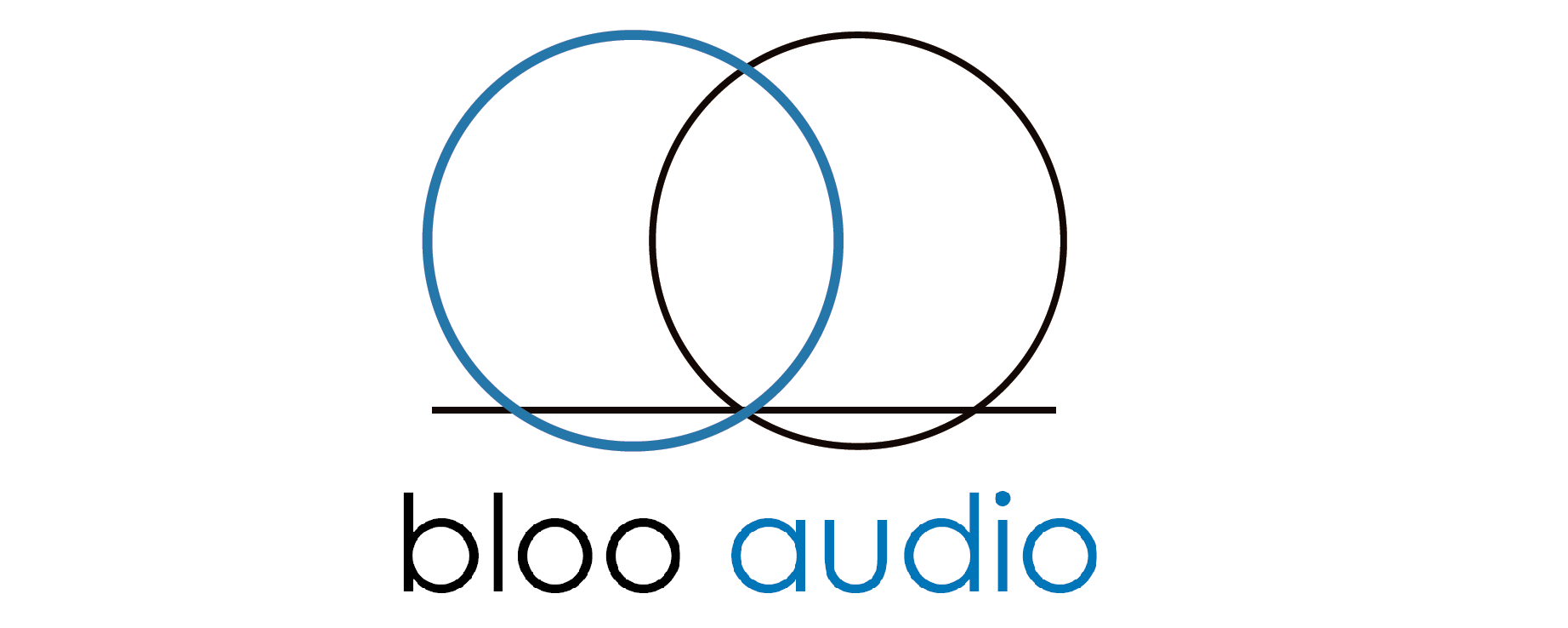Our microphone technology addresses the “voice interface” market with state-of-the-art miniature, low power microphone systems with high ambient noise rejection and reverberation cancellation.
Applications range from:
- speech recognition
- video and audio conferencing (Skype calls)
- voice identification
- monitoring, security, covert listening
- automotive communication systems
Our technology can be implemented in wired or wireless (Bluetooth) product solutions:
- Highly directional microphones – linear arrays. Nearfield (for headsets) / Farfield
- Miniature conference unit (circular array)
- Microphone or Conference accessory for smartphone
- Conformal arrays: microphone array hidden in a diffracting “shape”
- Special accessory for sound source localization
Our services include:
- Simulations
- Fast Prototyping – “Real time” simulations
- Custom algorithms
- Full audio architecture – Implementation on MCU or DSP
- Design of platform with MCUs, ADC, electret microphones – Digital microphones
- Advanced prototyping and validation
- End-of-line microphone calibration fixtures
Platforms: STM32F4 – STM32F7
Possible implementation in Kalimba DSP (CSR Bluetooth SoIC)
DEMO I: ARRAY51 MVDR beamformer – Acquiring Speech in a Challenging Environment
A karaoke night in a pub in Ottawa, with Nick H.
“Testing our technology in public places is always a great time. This city is convivial, people are friendly and they are always willing to help. That night, a client (Speaker2) was eager to participate in the experiment. We will listen to his precious advice”. Stephane D.
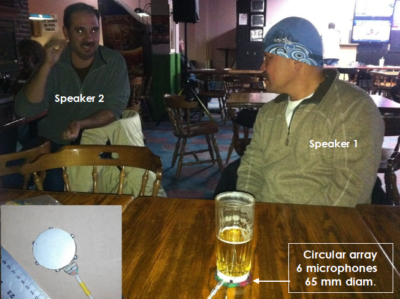
Test set-up
Fully calibrated 6 microphones circular array prototype. The array sits under a glass of beer.
- Electret microphones – preamplifiers – Multichannels sound card
- Diameter: 65 mm
- Speaker 2’s mouth is at about 1.60-1.80 m from the microphone array.
- Speech level at the array ~85-90 dB SPL
- Non stationary noise ~ Diffuse field (large number of loudspeakers)
- Bandpass filtering: wideband telephony audio [100, 7000 Hz].
- Array beamforming and Noise Reduction can be “steered” 360deg (every 30deg) (Automatic sound source localization is not recommended/available in very noisy environment)
The sound source of interest is Speaker2’s speech (“look direction”).
The beamforming algorithm preserves the speech frequency content. Speaker2’s voice can be identified.
Generalized Sidelobe Canceller (GSC): The 2-channels Noise Reduction post-processing introduces distortion depending on the attenuation gain.
Audio clip 1: Single microphone only | |
Audio clip 2: SNR ~ 8 -10 dB Undistorted speech | |
Audio clip 3: GSC Superdirectional Beamforming + Noise Reduction & Equalization SNR 12 ~ 15 dB | |
Recommended applications:
Security – Covert listening – Voice identification
Same algorithms can be used for speech recognition and sound source localization in quiet environments.
DEMO II: ARRAY 51 Binaural beamformer – A validation
The interest for Binaural Beamforming appeared in the hearing aid industry, where improving speech intelligibility in the presence of interfering sound sources remains one of the most sought-after features.
Binaural beamforming uses signals from arrays on both ears. It respects the 3D sound perception.
In spite of the small size of the arrays, Binaural beamforming offers strong interfering noise reduction potential due to the large inter-array distance and the natural attenuation provided by the diffraction of acoustic waves on the head.
Applications
- hearing aids and special earphones/headsets
- 3D recording with ambiant noise attenuation
- Real time 3D sound capture in the battle field, or for gaming
- 3D perception of the attenuated ambient sound field (smart earplugs)
MVDR Binaural beamformer – Simulations
Two small similar 3-microphones arrays are designed for a “Behind The Ear (BTE)” headset. The arrays geometry is undisclosed.
The arrays are adjacent to a large rigid obstacle: the head. Therefore the computation of optimal beamforming filters requires the use of numerical methods (BEM/FEM) for characterising the acoustic field surrounding the head for noise and speech sources.
Here optimal filters are computed and validated with an artificial head GRAS 45CB.
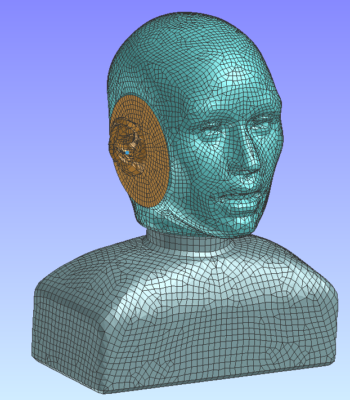 | 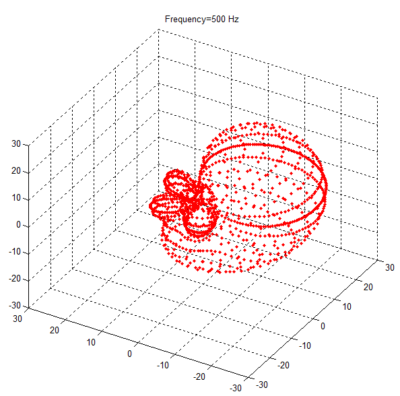 |
|---|---|
BEM/FEM model of GRAS 45CB | Monaural 3D beampattern 330 deg. |
MVDR Binaural beamformer – Validations
Validation in an Anechoic Chamber at 1 meter, directions 360 deg (counterclockwise). Frequency range: 0-8000 Hz.
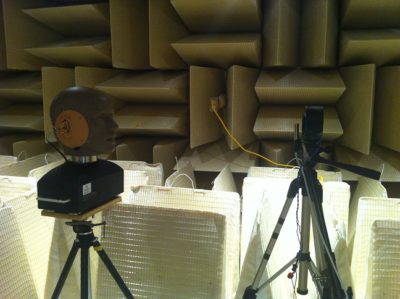 | 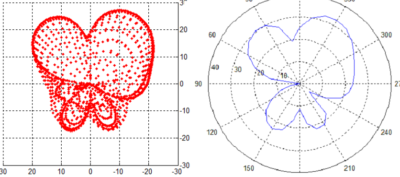 |
|---|---|
Test set-up in Anechoic Chamber | Validation in the horizontal plane - 330 deg - 1500 Hz |
MVDR Binaural beamformer – Tests
Tests are performed in a large reverberant room. Four large loudspeakers at each corner generate the interfering noise field. Speech is played with a smaller loudspeaker at one meter from the head, in the plane of the arrays.
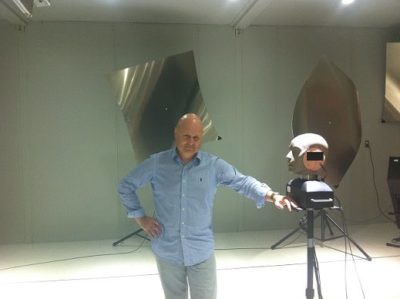 | 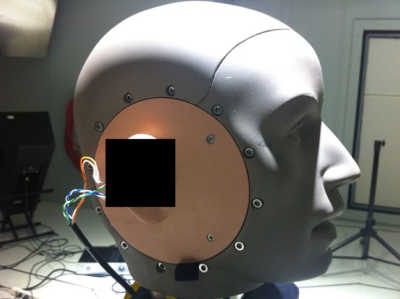 |
|---|---|
Test set-up in Reverberant Chamber | Microphone Array on artifical head's left ear |
Utterances Ui in French and their respective English translations:
U1: “Le clown est vraiment drôle” — “The clown is really funny”
U2: “Le coq réveille le village ” — “The rooster awakes the village”
U3: “Le marchand vend des bonbons” — “The merchant sells candies”
U4: “Le chien dormait dehors ” — “The dog was sleeping outside”
Recordings and Array processing are performed in 4 different conditions:
Silence – White noise – Industrial noise – Cocktail party
Speech starts at 5 s. A quality pair of headphones is required for the demo. The sound source is located at 60deg on the right.
Audio clip 1: Single microphone at each Ear Refererence Point. (L, R) | |
Audio clip 2: Binaural beamforming II | |
In spite of the size of the arrays, and microphone configuration, decent attenuation is achieved. Interfering Noise and Reverberations are well addressed by the beamformer: the speech sounds closer.
Generalized Sidelobe Canceller. We apply a 2 channels Noise Reduction. Agressive NR further improves SNR but introduces audible speech distortion. This method is intended to improve intelligibility in very noisy environments.
Audio clip 3: GSC Binaural beamforming II + Noise Reduction | |
